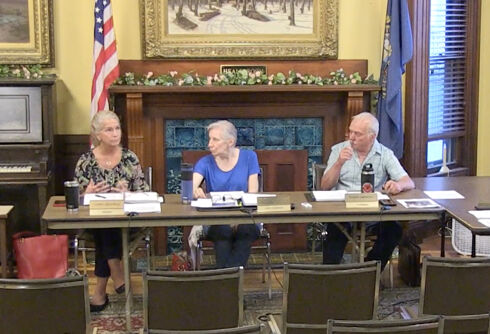A new study from Spanish researchers contradicts the long-held belief that same-sex sexual encounters have been common in all species since their appearance in the animal kingdom.
While the behavior has been documented in over 1500 animal species of all kinds, from sea urchins to bonobos, evolutionary biologist José Gómez and his colleagues believe the prevalence of same-sex encounters among mammals evolved in tandem with them living in social groups.
Related:
A man went on an anti-LGBTQ+ vandalism rampage. Now he’s facing hate crime charges.
Rainbow-painted doors at a church were defaced with “Cancel LGBTQ 2024.”
“It may contribute to establishing and maintaining positive social relationships,” Dr. Gómez of the Experimental Station of Arid Zones in Almería, Spain, and an author of the new study, told The New York Times.
Stay connected to your community
Connect with the issues and events that impact your community at home and beyond by subscribing to our newsletter.
The research differs from previous efforts to document same-sex encounters by looking for big evolutionary patterns that gave rise to the behavior in some species but not others.
Focusing on the 6,649 living mammals listed in the Mammal Diversity Database, the researchers noted which of them had been seen engaged in same-sex courtships, sexual behaviors or the formation of long-term bonds.
They came up with a list of 261 species that exhibited same-sex behaviors, or about 4 percent of all mammalian species.
Looking at the larger evolutionary tree, they discovered that the species engaging in them were scattered all across the tree’s branches, suggesting it arose independently for each.
“With the current data available, it seems that it has evolved multiple times,” Dr. Gómez said.
The analysis showed males and females were observed carrying out same-sex sexual behavior in roughly equal measure. In some species only one sex did, while in others, both males and females engaged in same-sex sexual behavior, like cheetahs and white-tailed deer.
The researchers concluded that the oldest groups of living mammals, including primates and cats, probably didn’t engage in same-sex sexual behavior.
But as new lineages evolved, some of those started exhibiting the trait, including apes, which branched off from other primates about 25 million years ago and evolved a much higher rate of same-sex sexual behavior than the earliest primates, like lemurs.
Based on those findings, Gómez and his colleagues then looked for traits the same-sex branches had in common and found they tended to be social species instead of solitary ones.
The researchers concluded that same-sex sexual behavior might be one of the ways that social mammals can manage unstable hierarchies, forming bonds and alliances to reconcile after conflict or channel aggression into courtship.
Dr. Gómez said the study, published on Tuesday in the journal Nature Communications, wouldn’t shed much light on human same-sex behaviors.
“The type of same-sex sexual behavior we have used in our analysis is so different from that observed in humans that our study is unable to provide an explanation for its expression today,” he said.















